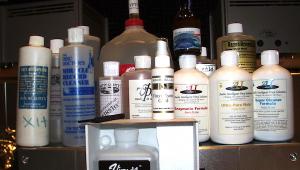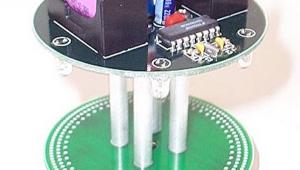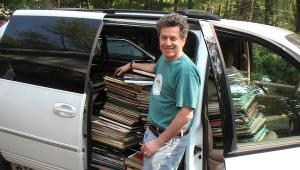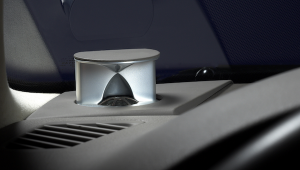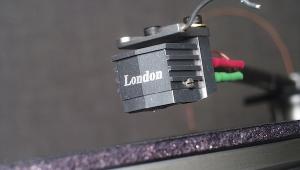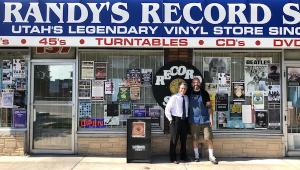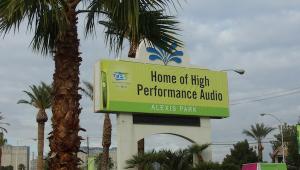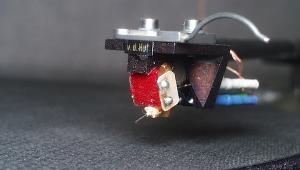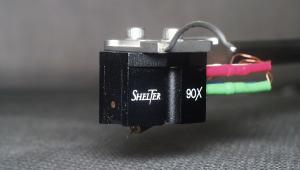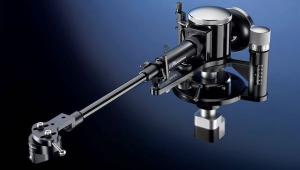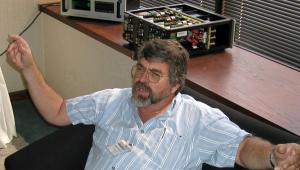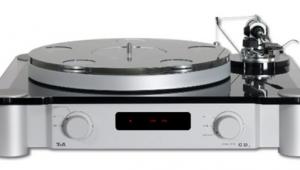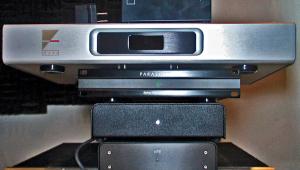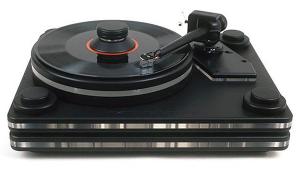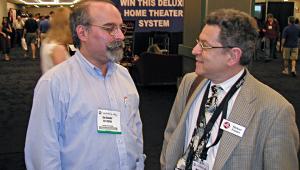My past returns ot haunt me! As with many audio "improvements" over time I liked less and less what these transformers did to the sound so I returned them. Oh well, live and loin.
Analog Corner #52
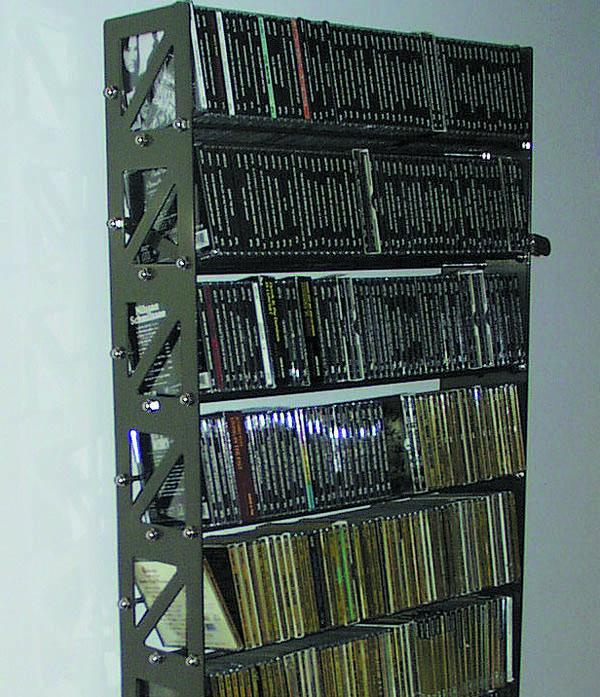
(Originally published in Stereophile, November 12th, 1999)
While the death of vinyl has been greatly exaggerated, the death of its inventor, unfortunately, has not. Last May 26th, Waldo Semon (a name straight out of central casting), inventor of vinyl, passed away in Hudson, Ohio at the mellow old age of 100. Dr. Semon invented our favorite synthetic back in 1926 at B.F. Goodrich, while trying to devise something else: an adhesive that would make rubber and metal stick together. Semon held 116 patents, and in 1995 was inducted into the US National Inventors Hall of Fame. He also invented and held a patent on bubble gum. Thanks to a reader for sending me his obituary.
Speaking of having one's bubble burst, how about this from CEMA (the Consumer Electronics Manufacturers Association), in their yearly overview publication, US Electronics Industry Today: "The industry experienced another look into the future with the introduction of the Diamond Rio portable 'flash memory' player using MP3 (MPEG-1, Layer 3) technology capable of downloading CD-quality music directly from the Internet." (My italics.)
Isn't that special? Speaking of the future, does the truth have one in this world? I'm beginning to doubt it.
SACD: "Analoglike''?
Well, maybe the truth—the musical variety and otherwise—does have a future. At HI-FI '99, Sony's introduction of its SCD-1 SACD/CD player included the essential truths we've been shouting for more than a decade: the admission that CD quality is not perfect, or even good enough. In fact, the design goal for DSD encoding and the resulting SACD format was to make the sound "more analoglike."
Has Sony succeeded? I was invited to hear the encoding system during its "breadboard" days at Sony's Manhattan recording studios a few years ago. A live jazz group was playing in the studio, and we were invited to sit before a pair of Wilson WATTs/Puppys and switch between the mike feed, a straight 16-bit conversion, 20-bit SBM, and the DSD encoding system used on SACD. DSD was as close to transparent as I've heard from a recording format, while 16-bit PCM flattened, narrowed, and hardened the sound. Still, some of the usual suspects attending my session claimed that there were no discernible differences between the live feed and any of the conversions.
Those suspects are still at it—industry and digital "experts" covering their butts by saying they're looking forward to the multichannel capabilities of SACD and DVD-Audio while saying nothing about the improved fidelity. Could it be that they really don't hear an improvement?
I was privileged to spend the past few weeks with the sample of Sony's new $5000 SACD player that Jonathan Scull reviews elsewhere in this issue, along with a stack of discs. Total novices heard the difference between CD and SACD in my system. Too bad some of those rump-covering "experts" are not looking for new careers; unfortunately, they'll probably try to kill SACD and DVD-Audio or downplay their sonic improvement over CD with the same energy and enthusiasm they expended in glorifying CD's "perfect sound."
Sony's new player is an impressive piece of machinery, physically, mechanically, and sonically. First of all, it's a damn good CD player. Sony has spent time and money designing a really great-sounding analog output section. The tonal balance of the player equals that of the $8000 Bow-Tech ZZ-8, with deep, satisfying bass, rich mids, and delicate, detailed highs.
But the player is a music reviewer's nightmare: It takes forever to boot up a disc. After you press Play and the cover languidly slides across the top of the chassis to seal the disc in the playback chamber, the front-panel readout spastically blinks "$Btoc reading" at you for what seems like enough time to boil an egg. Eventually, you can hear some tunes.
Hopefully that's not a "feature" of SACD. That aside, if this was the original CD format, this column might not exist save as an exercise in nostalgia. What's that you say? That's what it is now? I don't think so. Analog playback remains vital because CDs don't cut it in certain fundamental ways. SACD, at least based on my limited listening, levels the playing field between digital and analog playback.
Look, I'll always love records and record players, and there's no chance I'd trade my records in for the same title on SACD, even though, based on what I've heard, it sounds pretty much like analog minus vinyl's deficiencies. Records will always be records, and that's what I like to touch, smell, look at, play, hear, etc. But when you listen to SACD you'll hear something you never hear with CDs—something records almost always deliver.
Last year, when I interviewed Ray Davies, of the Kinks, he told me he "dreaded" the LP mastering process because the final product never came out sounding like the tape. I replied, "Do you really think that a CD sounds like a master tape? The frequency balance may be there, but isn't it fundamentally changed in some way?" Davies replied, "Oh yes! It's not sitting on anything. I can't explain it any other way."
I think everyone reading this column understands what he was getting at. With SACD, the music is definitely "sitting" on something. There is a weight and solidity to the musical picture that equals what you get with a great record or a great tape. With SACD, you won't lose interest after a few minutes, because the picture is so damn convincing.
Unfortunately, some of the music that accompanied the player was dreck, like Telarc's On Broadway with Eric Kunzel conducting The Cincinnati Pops in a program of music America apparently loves and I hate—selections from Miss Saigon, Les Misérables, and other examples of the rambling, tuneless, pseudo-light-operatic swill that passes for "Broadway" today, thanks to Andrew Lloyd Webber and the dreadful Frank Wildhorn (Jekyll and Hyde, The Scarlet Pimpernel, and the huge flop The Civil War), who have reduced Broadway "music" to long commercial jingles.
The Kunzel disc made the orchestra sound as if it was on Broadway and the mikes were in Cincinnati, so distant was the orchestral picture. But whereas a CD of such a recording might sound watery and indistinct, the SACD floated a precisely defined, solid orchestral picture, with plenty of there there, and a clear sensation of the event occurring before your ears—something CD has a great deal of trouble with.
I've been critical of Tom Jung's DMP recordings because I find his soundstages frequently gimmicky, even grotesque, but on the DMP DSD sampler there's a choral track, "Gaudeamus," that is absolutely stunning in its realistic portrayal of massed voices. More of this, Tom!
Water Lily Acoustics provided two of the best discs, musically and sonically: Nature's Realm, its recent all-analog recording of the Philadelphia Orchestra with Wolfgang Sawallisch; and Fascinoma, an exotic new one featuring treated-trumpet great Jon Hassell. Both are also on CD and highly recommended. What a pleasure to hear a well-recorded symphony orchestra; reproduced via SACD, its solidity and weight created a picture that was thrillingly "there."
The AudioQuest sampler BluesQuest, a hybrid disc containing both CD and SACD layers of very familiar material, clinched it for me. The differences between the two versions of Terry Evans' "Get Up, Get Ready" and "Mighty Sam McClain's "Too Proud" were monumental—all of the uninitiated for whom I auditioned the tracks heard the differences and were able to describe them without prompting. Watch for the comments of the CD apologists.
Mighty Sam's voice, dimensionless and textured like aluminum foil on the CD version, lived on the SACD version, as it does on the LP I compared it to. The cymbals' detail and delicacy on LP and SACD turned to metallic hash on the CD. And the size of the picture on the SACD rivaled the LP. It was BIG and deep like the LP—but, of course, we know that the big, deep LP soundstage is an artifact of the L–R information, right? God, I'm enjoying this period of time, even as I'm having trouble convincing myself that SACD—or DVD-Audio, for that matter—has much chance of success in the marketplace.
Here's why: The average guy or gal is more than happy with CD and doesn't listen to music with the sit-down intensity we do, nor does he or she own the kind of equipment that will make clear the improvements wrought by the higher-resolution formats. That leaves the marketplace to us, and, despite our best efforts, there are simply not enough of us.
That's why I think Sony has the best handle on the situation. They've aimed SACD squarely at us audiophiles, with a really great-sounding but expensive two-channel player that they hope will crack the market. Sony hopes we'll buy it (and less opulent but, hopefully, equally fine-sounding players) for CDs as well as the new discs that Sony, Telarc, DMP, AudioQuest, Mobile Fidelity, et al, will be producing.
The DVD-Audio folks are taking a different and, I think, unrealistic tack. They're assuming that they'll tap faster into the broader home-theater market, by releasing multichannel discs consumers can play on their home-theater systems. I don't think so. In the 1950s and 1960s, everyone sat and listened to music. It was a common activity, much as sitting and listening to the radio was during 1940s. Today, only audiophiles sit and listen to music. Sad but true. Most everyone else uses it as "lifestyle" sonic wallpaper. Surfing the Net, now that's a sit-down activity!
Therefore, multichannel-audio music DVDs will potentially appeal only to audiophiles, most of whom are not yet willing to commit to the expense of five channels of high-quality sound—especially since most of the mixes have been, and I'm afraid will continue to be, 1970s "quad''-style abominations.
Most home-theater setups are in common family rooms because watching movies is a family experience. Listening to music is not. And anyway, what are the chances that kids will bring their rap and speed-metal 5.1-channel DVD-Audio discs into the home theater room? Not good. The car is the best hope, but that will require DVD-Audio in-dash units. That's why I think Sony will be the tortoise and the DVD consortium the hare, despite Sony's deeper catalog. But then, I'm the guy who said, after a 1980 visit to Apple, "Who the hell wants a computer in their home?"
Meanwhile, if you can buy a great-sounding CD player that can also do SACD, why wouldn't you? But until there are multiformat players capable of both SACD and DVD-Audio playback (feasible, since SACD is encoded onto a DVD), I don't think either format has much of a chance.
A coherent light at the end of the tunnel?
Cartridge and speaker designer Sao Win (remember his strain-gauge cartridge?) is working on a new cartridge that uses a cantilever and stylus and a laser beam to track grooves in vinyl. The stylus and cantilever are not connected to a coil or motor mechanism of any kind. The laser measures the displacement of the stylus/cantilever, and that information is used to generate the voltage. With no mass attached, the stylus/cantilever can probably track perfectly at under a gram, or so I've been told. This is preliminary information I've recently received. When the product is finished, I'll be sent a review sample.
This exciting development has the potential to sound great while ending record wear as we know it. Finally—"perfect sound forever''!
TDS Passive Harmonic Enhancement System
Audiophiles are, for the most part, "purists'': no equalizers in the circuit (never mind that the RIAA section of your phono preamp is one), no effects boxes or extraneous electronic clutter. You older guys and gals maybe flirted with a Dynaco Quadapter and a pair of surround speakers in the '70s (I did), or maybe even a Barcus-Berry BBE processor in the '80s (tried it, didn't like it—it added things to the signal that were not originally there). But usually, after adding something that delights us for a while, we end up ripping it out and going back to the simplest setup possible.
Had TDS's little $395 black box not been lurking in the KR Enterprise/Von Schweikert system that stopped me in my tracks at last year's CES, I probably wouldn't have bothered with it. But TDS's VP of marketing, Chris Knecht, and Art Garcia, who co-invented the patented process, offered it to me for review, and I agreed.
The Passive Harmonic Enhancement System (PHES) is a totally passive, signal-source–driven inductive circuit that goes between preamp and amp, or can be used in a tape loop on integrated amps or receivers. There are no caps or resistors, and no power supply. What's in the PHES is a "system of transformer couplings placed in parallel with the source and load of corresponding sound-reproducing equipment," according to TDS, which also claims bandwidth to be DC–100kHz. TDS claims low harmonic distortion for the process, and says it introduces no phase changes, time delays, or harmonics.
Nor does it have to be in a black box. Art Garcia demonstrated a computer program that applied the PHES process to the tiny speakers built into his laptop. It can also be put into an analog or digital IC, or even built into a set of interconnects.
According to Garcia, the PHES process nonuniformly amplifies "select frequencies already present in the audio signal that are not as perceptible to the human ear." We all know the Fletcher-Munson equal-loudness-contour curve, right? According to TDS's literature, the sensitivity problem is compounded by the "energy loss that an audio signal experiences during the playback process." Garcia got into this via his father, who was researching and developing a sound process that would enhance Sonar recognition. The younger Garcia, an audiophile, decided to find a way to incorporate the technology into audio.
The transformer coupling results in a 3dB voltage gain, so all comparisons were done using an SPL meter to ensure levels were equalized. "First, do no harm," is the primary demand I place on any "enhancement" technology, so that's what I listened for first, using delicate, detailed source material like Classic Records' The Royal Ballet 45rpm reissue. I also used DCC Compact Classic's superb reissue of Nat King Cole's Love is the Thing, and both an original Vanguard pressing and Analogue Productions' reissue of Songs of the Auvergne, which features an ultra-natural recording of a female voice. I also listened to a 45rpm British 12" of Pete Townshend and Ronnie Lane's string-drenched and brilliantly recorded "Street in the City," from Rough Mix. I auditioned the TDS box in my old listening room and my new one, through Audio Physic Virgos and Sonus Faber Amati Homages.
On the negative side, there was a barely perceptible loss of transparency and high-frequency sparkle, and a slight muting of the leading edges of transients. On The Royal Ballet, for instance, there is a delicate tambourine placed at the back of the stage. With the PHES, a slight opacity set in, reducing the shimmer. The pick-on-guitar-string sound in "Street in the City" was slightly dulled. But that was it for the negatives, which were very subtle, and not really noticeable except via direct comparison. Still, for some of you that might be enough to just say no.
Fortunately, the positives were subtle yet compelling on most program material—I heard nothing jarring, nothing that let me know I was hearing a "processed" signal. There was no noise, no "pumping," and no sonic seams. Were you to play your system for a friend familiar with its sound, he might not even notice a difference—until you took the box out.
With the box in, the sound was uniformly richer, yet with greater detail. Instruments seemed to sound more like what they sound like, with better separation. For instance, on "When I Fall in Love," on the Nat King Cole album, the tonal distinctions between violins and cellos were more pronounced than I was used to—and overall, more physically palpable and three-dimensional. The overall soundstage was likewise improved, but just subtly, and proportionally. The effect was pleasing, but neither vulgar nor artificial-sounding.
I liked what the TDS box did in my system. I'll use it, especially when listening to CDs, but I can't agree with some of the wilder endorsements. Recording engineer Tom Dowd (the Allman Brothers, and hundreds of classic Atlantic studio recordings) is quoted as saying "TDS adds back what I would originally hear in the studio, but could never capture on the finished product." Hmm.
Eight-time Academy Award–nominated film mixer Rick Kline said that "The music with TDS sounded as if the instruments were placed not only left to right, but spatially throughout the room in a three-dimensional manner, without any apparent sweet spot, as if the instruments were being played before me...live!" Of course, that's a good description of a properly set-up high-end audio system without TDS.
TDS was used for certain sound elements in Jerry McGuire and My Best Friend's Wedding, which is a Dolby Digital demo disc among videophiles; and the entire final mix of The Mummy was passed through five channels of TDS processing on its way to film and DVD.
Even electric-car advocate and "actor/audiophile" Ed Begley, Jr. chimes in: "While listening to TDS on my home stereo system, I knew without a doubt that I was listening to music played before me...live! It was truly amazing! There is nothing on the market like TDS. It's easy to install; it's affordable; and most important...TDS will bring you so much listening enjoyment."
The more modest your system, the more I think the TDS Passive Harmonic Enhancement System will improve it. In any case, this $395 box is available with a 30-day money-back guarantee, so if I've whetted your curiosity, you can check it out for yourself risk-free. There's a version for the same price with a switch so you can do your A/B comparisons immediately and conveniently, but that just puts another impediment in the line; go for the switchless model.
The nutz'n'boltz of CD storage
I surfed the Web for a shallow and space-efficient CD storage rack, and found a great one—part of a line of storage racks from Boltz (see photo). It may not be to everyone's taste, but I like it. Mine was an assemble-it-yourself stand, but a few days after I bought it they changed the design and can now send it to you assembled. (It still looks basically the same, but the side units are one piece—mine are bolted together.) The unit is 48" tall, 24" wide, and just 6" deep, yet holds 600 CDs! Price is $249. You can double or triple its capacity with $199 extension kits. Check it out at http://www.boltz.com/.
Good room/bad room
My new, bigger room has really been a problem: higher ceiling, more open space, and bare, reflective walls. I needed treatment (people have been saying so for years), but first I needed to find the optimum location for my Sonus Faber Amati Homage speakers. I worked for a week using intuition, rules of thirds, etc., and got nowhere. For reasons I haven't figured out, the Audio Physic methodology (see "Fine Tunes," October 1998, p.63) wasn't cutting it either.
In desperation, I sent for RPG Diffusor Systems' Room Optimizer software (sold by, among others, Audio Advisor). Because there is no Mac version (bad dog!), I had a friend run the program.
To greatly simplify the procedure: You plug in your room dimensions (they must be rectangular), and Room Optimizer outputs the precise location where your room's modal response is flattest and speaker boundary interference is minimized. It also tells you the best place to sit.
The program told me to put the speakers less than 3' from the front and side walls. Here I move to a room 19' long, hoping to generate a big picture with lots of physical space behind the speakers, and they're telling me to put them nearly against the wall. But I was desperate, so that's where I put them, and...
KA-BOOM!!! Deep, deep bass; smooth, uncolored response; outstanding dynamics—everything I remember the Amatis doing in my dinky little room. I'm not finished finessing the speaker placement, but the Room Optimizer has given me a great starting point that's nowhere close to where I would have imagined it might be. Now I can actually consider returning to reviewing equipment.
- Log in or register to post comments

All of the Stones catalog has been transferred to DSD (SACD) so the Blu-ray PCM tracks, regardless of resolution were sourced from DSD. Therefore at best, the files could sound as good as DSD but not better. DSD to PCM transfers can only lose something "in translation." You'd have to compare Grrr on SACD with the PCM version on the Blu-ray to make an adequate comparison.

Mike,you've hit it right on the head!!It's the whole tactile experience with LP's...loading on the TT,setting the tonearm,and away you go,plus you tend to play the whole album side because you have to get out off your fat rear-end(not you)and move the stylus.You can't just track forward as on digital.I have an SACD player,and it's really good...possibly not better.I also still like to read Newspapers and Magazines.#OLD FART.

Don't forget: DSD can only be converted on 1-bit DAC chips, and PCM can only be converted on parallel resistor DAC chips, so it is not really possible to "compare the sound of DSD to PCM". A vastly larger diffference in sound quality is due to the Jitter amount during conversion. So it is easy to set up a test where:
(1) DSD is made to sound like crap.
(2) PCM is made to sound heavenly in comparison.
(3) DSD is made to sound great.
(4) PCM is made to sound like crap in comparison.
You are never comparing DSD to PCM directly in terms of sound. You are only comparing one data conversion process to another.
If you compare these formats on a universal player, you had better first figure out what DAC chip the thing uses, because if it uses a 1-bit DAC, then it will "make" DSD sound better and PCM worse. If it uses a ladder DAC (Parallel resistor) then it will "make" PCM sound better and DSD sound worse.
This is because the digital format which undergoes the least processing prior to conversion will always sound best.
PCM through Ladder DAC = little processing = sounds good!
DSD through Ladder DAC = much processing = sounds as good as the processing corrupts the circuitry.
PCM through 1-bit chip = much processing = sound as good as the processing corrupts the circuitry.
DSD through 1-bit chip = little processing = sounds good!
So really it is most impotant to set up the test correctly by knowing the conversion intricacies instead of thinking "I am comparing DSD to PCM". You almost never are comparing DSD to PCM. Because most of the time you are using the same DAC for the conversion.
Louis Motek

As smash karts, this PHES is a passive device.

